
Beginning Microsoft Word Business Documents - From Novice To Professional (2006)
.pdf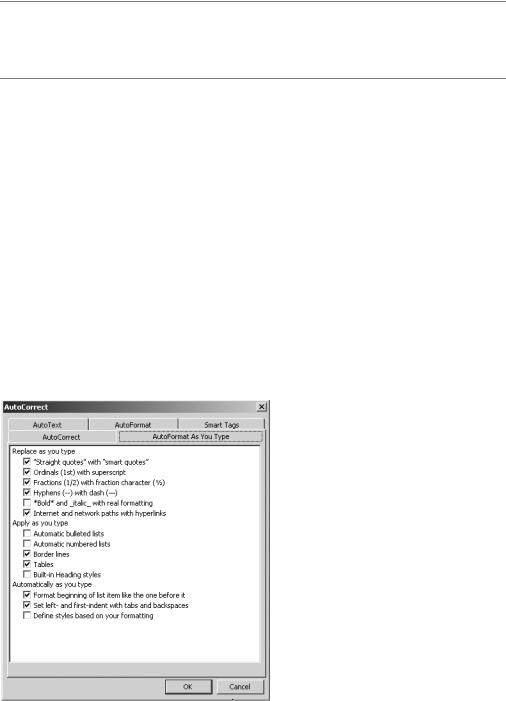
96 |
C H A P T E R 5 ■ C R E A T I N G L E G A L D O C U M E N T S |
■Note You can also use the Paragraph formatting dialog box to set the right and left indents. However, the sliders on the Ruler are often easier, as a dashed line appears, showing you the position of the indent. You can instantly judge how your document will look without having to guess.
Creating Bulleted or Numbered Lists
There is a good chance that you will want to use bulleted or numbered lists in your document. These types of lists are notoriously difficult to work with in Word, although over the years Word has significantly improved the way it handles lists.
Word generally tries to create a list if you begin a paragraph with a number or a symbol. When you end the paragraph by pressing Return or Enter, it will AutoFormat the paragraph using a list style.
This AutoFormatting is frustrating for many users, particularly if a list is not desirable. And, if you have multiple paragraphs within a list item, it can be difficult to have Word format the list correctly.
I generally recommend that people disable lists in Word’s AutoFormat section. This will alleviate much of the frustration. To do this, click Tools AutoCorrect Options. On the AutoFormat As You Type tab, shown in Figure 5-13, deselect Automatic bulleted lists and Automatic numbered lists.
Figure 5-13. The AutoFormat As You Type tab
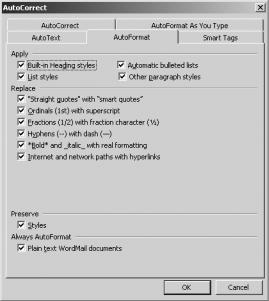
C H A P T E R 5 ■ C R E A T I N G L E G A L D O C U M E N T S |
97 |
On the AutoFormat tab, shown in Figure 5-14, deselect Automatic bulleted lists and List styles. Click OK.
Figure 5-14. The AutoFormat tab
Now you can create the lists as you would like by inserting numbers or symbols for list items. Then you can adjust the indents as you please. For some, creating lists manually is preferable to messing around with Word’s lists feature. However, keep in mind that lists won’t automatically update when individual list items are moved or deleted.
But, for short lists, it is much easier to let Word create the list for you. To begin a list, simply click either the Bullets or Numbering button on the Formatting toolbar.
When you create a list using the toolbar buttons, it is best to allow Word to format the list automatically. Then if you want to make changes to the format, you can do so in one fell swoop when the list is complete.
To change the format of a bulleted list, double-click one of the bullet points. The Bullets and Numbering dialog box opens to the Bulleted tab, as shown in Figure 5-15. There are a number of predefined list formats from which you can choose. Simply highlight one of the styles and click OK.
Or, you can customize a list style by clicking the Customize button. In the Customize Bulleted List dialog box, you have a number of options, as you see in Figure 5-16. You can select from one of the existing bullet characters by selecting it. Or you can select
a different symbol by clicking the Character button. The Font button allows you to change a bullet symbol’s font.
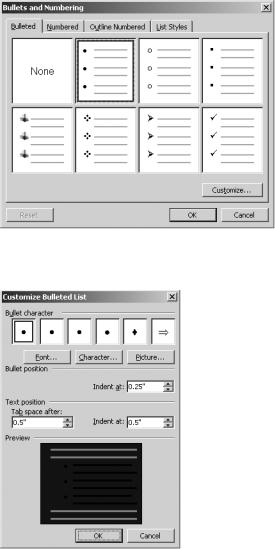
98 |
C H A P T E R 5 ■ C R E A T I N G L E G A L D O C U M E N T S |
Figure 5-15. The Bulleted tab of the Bullets and Numbering dialog box
Figure 5-16. The Customize Bulleted List dialog box
In the Bullet position section, use the control box to select the indentation for the character. The Text position section changes the position of the text relative to the left margin. Tab space after sets the position of the first line of text. Indent at changes the position of all subsequent lines.
Once you have made your changes, click OK on each of the open dialog boxes.
To change the formatting of a numbered list, double-click one of the numbers. The Bullets and Numbering dialog box will open to the Numbered tab, as shown in Figure 5-17.
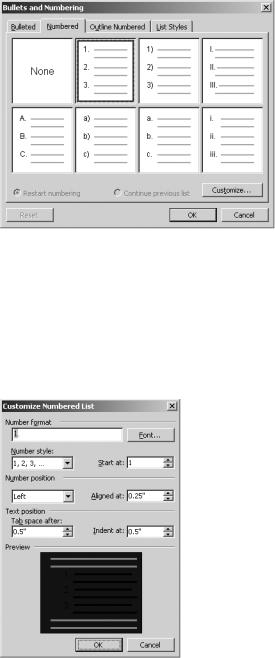
C H A P T E R 5 ■ C R E A T I N G L E G A L D O C U M E N T S |
99 |
Again, Word gives you the option of selecting from a predefined format. Select one and click OK to apply it. Or, you can click Customize to make changes.
Figure 5-17. The Numbered tab of the Bullets and Numbering dialog box
In the Number format box of the Customize Numbered List dialog box, shown in Figure 5-18, you can enter a number and a character, if you want a special format. The Font button provides a way for you to change the font format for the list numbers. You can use the Number style box and the Start at box to apply a specific style of numbering and to change the number at which the list will start.
Figure 5-18. The Customize Numbered List dialog box

100 |
C H A P T E R 5 ■ C R E A T I N G L E G A L D O C U M E N T S |
■Tip If you are continuing a previous list, don’t use the Start at option to change the list. If you delete an earlier list item, the current list won’t automatically update. Rather, use the Continue previous list option in the Bullets and Numbering dialog box.
In the Number position section, use the control box to select the indentation for the number. The Text position section changes the position of the text relative to the left margin. Tab space after sets the position of the first line of text. Indent at changes the position of all subsequent lines.
Once you have made your changes, click OK in each of the open dialog boxes.
If you want to remove a bullet point or number from a paragraph, simply position the cursor before the first character in the paragraph text, then press the Backspace key. The bullet or number will be removed; the rest of the list updates automatically.
At the end of a list, press Enter or Return twice to turn off bullets and numbering and to return to a normal paragraph style.

C H A P T E R 6
■ ■ ■
Creating Data Sheets
Data sheets often require intricate formatting. In addition to text, you will want to include bulleted lists enumerating product features and diagrams of specific components. Fortunately, Word has features that will simplify the process of creating your data sheet.
You can see a sample data sheet with the downloads for this book at the Apress web site (http://www.apress.com).
Specifying Page Setup
Before you enter any text or diagrams, specify the page setup for the entire document. You may decide later to alter the page setup in specific parts of your data sheet. Or, you may already know that the page setup will differ in certain areas. This is okay. For now, you are setting the predominant page layout for your document.
Access the Page Setup dialog box by clicking File Page Setup. Click the Margins tab to open the settings for the margins, as shown in Figure 6-1.
The default settings for the Normal.dot template are 1 inch at the top and bottom of the page and 1.25 inches at either side of the page. You can enter new margin sizes if you wish.
Next, click the Paper tab in the Page setup dialog box (see Figure 6-2). In the Paper size section, use the drop-down box to specify the paper size.
101
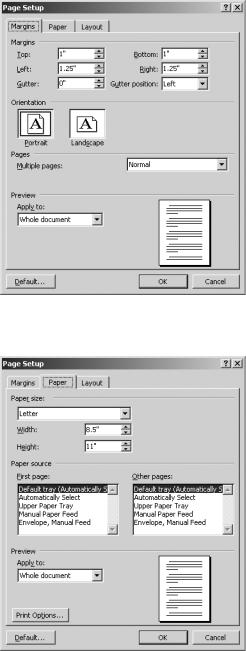
102 |
C H A P T E R 6 ■ C R E A T I N G D A T A S H E E T S |
Figure 6-1. The Margins tab of the Page Setup dialog box
Figure 6-2. The Paper tab of the Page Setup dialog box
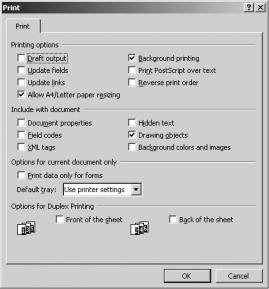
C H A P T E R 6 ■ C R E A T I N G D A T A S H E E T S |
103 |
Use the boxes in the Paper source section to specify the printer’s paper tray(s) for the first page of the data sheet and for the subsequent pages. In the Preview section, opt to apply the changes to the whole document.
Click the Print Options button to review the settings, as shown in Figure 6-3. Deselect Draft output if it has been selected. You should select Drawing objects.
Figure 6-3. The Print dialog box
Once you have made your selections, click OK.
On the Layout tab, shown in Figure 6-4, check the document’s vertical alignment. Select the alignment in the drop-down box. Opt to apply the changes to the whole document or from that point forward, then click OK.
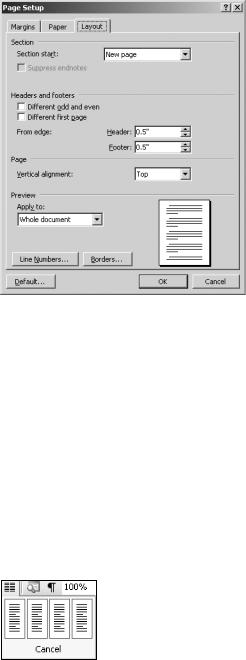
104 |
C H A P T E R 6 ■ C R E A T I N G D A T A S H E E T S |
Figure 6-4. The Layout tab of the Page Setup dialog box
Inserting Columns in Your Data Sheet
Columns can help you arrange product features neatly. Combined with bulleted lists, they will lend a refined look to your document. However, columns can be tricky if you don’t use them correctly. But when you understand a few key points, they’re relatively simple.
The easiest way to apply columns to a portion of your document is to use the Columns button on the Standard toolbar. Select a portion of your document and click the button. A drop-down menu gives you the option of dividing the section into four columns, as you see in Figure 6-5. However, if you hold the left mouse button and drag to the right, you are given the option of adding six columns. Simply highlight the number of columns you want to apply.
Figure 6-5. Creating columns using the Columns toolbar button
This doesn’t give you many choices. For more advanced options, click Format Columns.
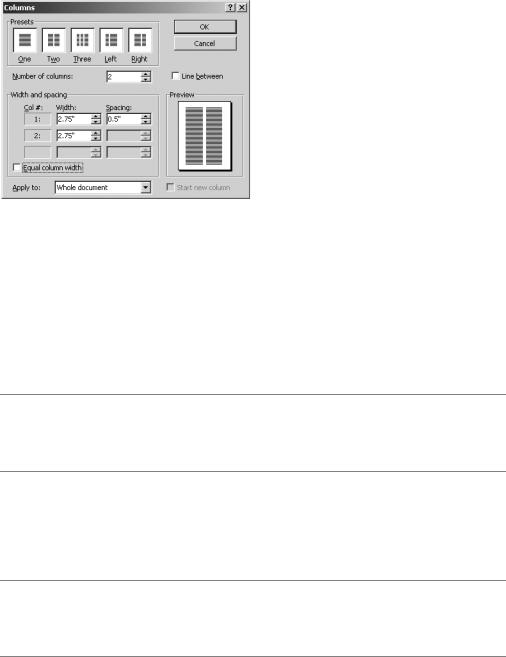
C H A P T E R 6 ■ C R E A T I N G D A T A S H E E T S |
105 |
You can select from the Presets column designs shown in Figure 6-6. Or, you can specify the number of columns you want by using the Number of columns box. Word supports up to 12 columns.
Figure 6-6. The Columns dialog box
By default, Word makes each column identical in width. But you can set the width for each column independently. Deselect Equal column width. Then use the controls to specify width, in inches, for each column. The Spacing boxes let you set the distance between the columns.
If you would like a line between each column, select Line between. Use the Preview section to see how your columns will look.
■Tip For greater control over the appearance of columns, you can insert column breaks. This will push all text after the break into the next column, so you won’t need to enter returns to move text. To insert a column break, click Insert Break. Select Column break and click OK.
Finally, choose Selected text in the Apply to drop-down box. Or, you can select Whole document to apply it to the entire document. If text isn’t selected, your choices are This point forward or Whole document. Click OK.
■Caution Columns can become problematic in some situations. That’s because Word must create a new section when you change the number of columns in your document. So keep this in mind if you’re working with other elements that change from section to section.
